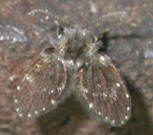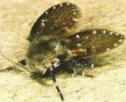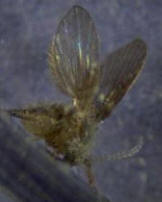
- Eggs, laid by females hatch into pale-colored larvae. Following a
feeding period, larvae pupate and soon emerge as adult
 flies. Adults
live only 3 to 4 days without food, but they can survive for weeks if
nectar or other liquid carbo-hydrate food sources are available
flies. Adults
live only 3 to 4 days without food, but they can survive for weeks if
nectar or other liquid carbo-hydrate food sources are available - Moth flies lay eggs in a mass of 30 to 100 which hatch in less than 48 hours.
- The larval stage lasts from 9 to 15 days and the pupal stage lasts from 20 to 40 hours.
- Adult flies may live about 3 weeks.
- Control of moth flies requires locating and eliminating larval
breeding sites. This may be very difficult to do; perseverance
 and
imagination will be required. One way to check individual drains as
possible breeding sites is to cover the drain with a plastic film taped
to the floor or fixture (e.g. a clear plastic bag). If the flies are
breeding in that drain they will accumulate underneath the film within a
day or two.
and
imagination will be required. One way to check individual drains as
possible breeding sites is to cover the drain with a plastic film taped
to the floor or fixture (e.g. a clear plastic bag). If the flies are
breeding in that drain they will accumulate underneath the film within a
day or two. - The only effective method to eliminate drain flies developing in drains is to clean the inside of the drain pipe to eliminate the organic matter. Clean slow-moving drains with a stiff brush or other tool. Drains that cannot be scrubbed can be rinsed with water under high pressure or "sterilized" by slowly pouring boiling water down along the sides of the drain pipe. Another possibility is the use of a bacterial drain treatment that biodegrades the organic matter. Follow label directions carefully for best results.
- There is no benefit to treating drains with bleach or ammonia. Household insecticides can be used to control the adult flies, but this treatment will provide only very temporary benefit unless the source of the larvae is also removed.